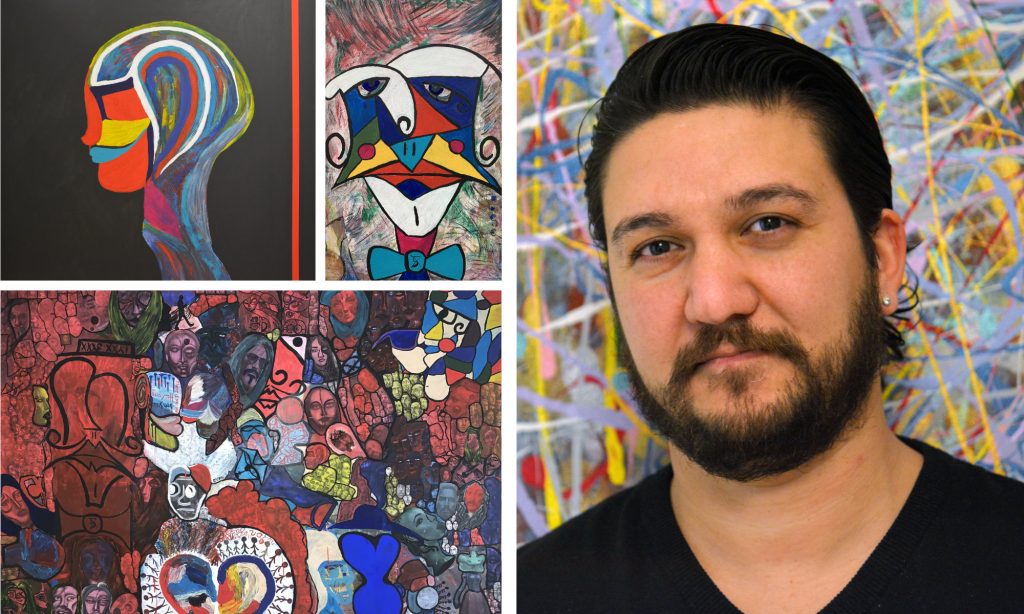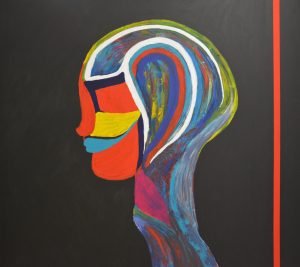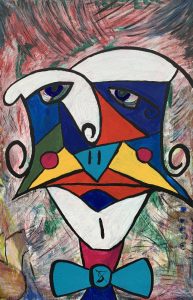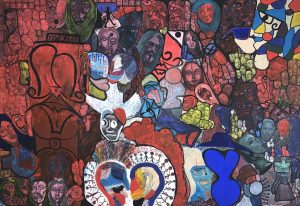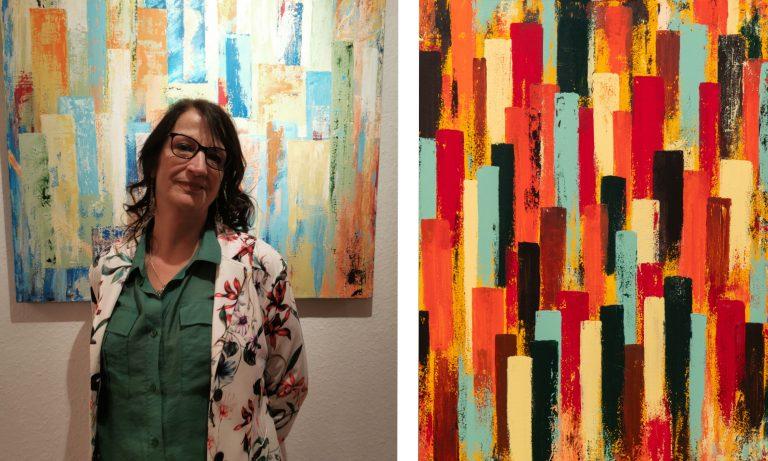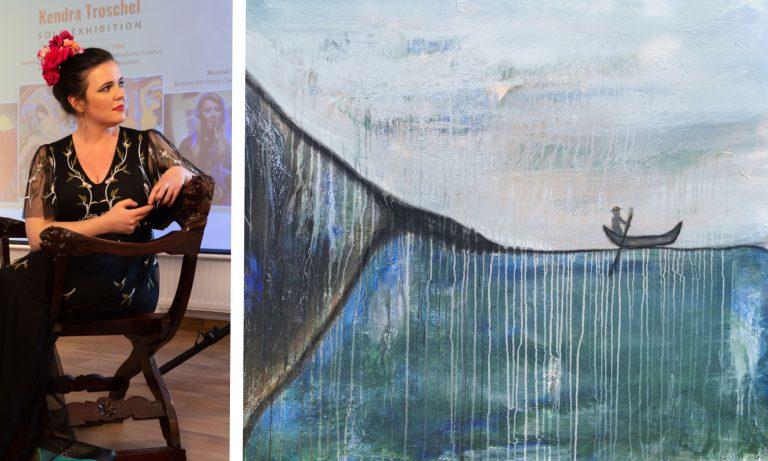Ali Kasap, born in 1985 in Esslingen am Neckar, is an emerging contemporary artist whose work has garnered international recognition. His artistic breakthrough came in 2020 when he participated in a prestigious art event in Luxembourg, earning two awards. This success led to further international showcases, including exhibitions at an art museum in Chongqing, China, in 2021 and 2022, followed by a group exhibition in Hamburg in 2023—each organized by Pashmin Art. With more projects planned for 2025 and 2026, Kasap continues to refine his ever-evolving style, which resists predictability and embraces fluid creativity.
Ali Kasap’s works exhibit a striking engagement with formal elements—composition, color, line, texture, and spatial arrangement—demonstrating a dynamic interplay between structure and expression. By analyzing Red Line (2023), Francois (2023), and Red Room (2024) through a formalist lens, we can better understand Kasap’s distinct visual language and his exploration of abstraction, geometry, and figuration.
Composition & Structure: The Tension Between Order and Chaos
The three paintings reveal varying approaches to composition, each balancing structure and spontaneity in unique ways. Red Line employs a bold, centralized figure with defined contours and a stark vertical red line, creating a sense of balance and duality. The structured nature of the composition contrasts with the gestural brushstrokes and textural impasto, reinforcing themes of control versus fluidity.
Francois takes a more graphic and symmetrical approach. The exaggerated portrait dominates the canvas with geometric facial features arranged in a puzzle-like manner. The central placement of the figure and its clear segmentation into colored sections lend a structured clarity to the composition, yet its expressive distortions introduce an element of playfulness.
In contrast, Red Room is a densely populated, chaotic tableau of overlapping figures, abstracted faces, and fragmented elements. The composition feels almost tapestry-like, rejecting a single focal point in favor of an interconnected, layered arrangement that demands the viewer’s active engagement. The inclusion of collage elements further disrupts spatial coherence, adding to its multidimensional quality.
Line & Shape: A Bold Visual Language
Line is an essential component of Kasap’s work, providing structure and rhythm. Red Line features fluid yet defined contours, using sweeping curves and angular divisions to segment the face and skull. The presence of the stark, straight red line on the right side introduces a rigid, contrasting element, reinforcing the painting’s theme of boundaries.
Francois presents some of the most striking use of line, with thick black contours framing each section of the face in a manner reminiscent of stained glass. The exaggerated, curling eyebrows and the structured facial divisions emphasize a dynamic, Cubist-like fragmentation, reinforcing the portrait’s stylized and abstracted nature.
Conversely, Red Room is filled with a variety of line qualities—thick, expressive brushstrokes define certain forms, while intricate, interwoven lines create patterns and textures. The density of lines contributes to the painting’s layered complexity, making it feel almost like a collage of different visual motifs coexisting within the same plane.
Color: Vivid Contrasts and Symbolic Emphasis
Kasap’s use of color is both vibrant and purposeful, enhancing the compositional dynamism of his works. Red Line relies on a limited but striking palette, with red serving as both a compositional and symbolic element—conveying themes of passion, urgency, and division. The dark background amplifies the boldness of the colors, making the figure stand out in high contrast.
Francois employs a highly saturated primary color scheme, using bold blues, reds, yellows, and greens. The segmented facial features recall a Fauvist or Cubist approach, where color serves to emphasize structure rather than naturalistic representation. The contrast between the solid color fields and the textured, expressive background further enhances the painting’s dynamism.
In Red Room, color becomes a tool for visual chaos and richness. Deep reds, blues, and earth tones intermingle with collaged elements, contributing to the painting’s layered complexity. The use of repetition and variation in color creates a sense of visual rhythm, guiding the eye through the intricate narrative of figures and symbols.
Texture & Technique: The Interplay of Surface and Depth
Kasap’s diverse techniques—including brush, spatula, and collage—add tactile variation to his works. Red Line utilizes a combination of smooth brushwork and textured spatula application, creating a balance between fine detailing and gestural spontaneity.
In Francois, the juxtaposition of textured and smooth surfaces is evident, with the rough, expressive background contrasting sharply with the flat, cleanly segmented colors of the portrait. The spatula work in the background adds a sense of movement, preventing the composition from feeling static despite its graphic clarity.
Red Room, on the other hand, fully embraces texture through the integration of collage and impasto techniques. The layering of materials gives the surface a sculptural quality, making it feel both physically and visually dense. This contributes to the painting’s overall sense of fragmentation and multiplicity.
Space & Depth: Flatness vs. Dimensionality
While all three paintings lean toward a flattened pictorial space, they achieve depth through layering, color contrast, and texture. Red Line utilizes a stark black background to isolate the central figure, emphasizing its sculptural presence. The contrast between the fluid, painterly application and the rigid red line creates an illusion of spatial separation.
Francois maintains a largely flat aesthetic, but the interplay of bold outlines and textured background introduces a slight illusion of dimensionality. The segmentation of the face into distinct color fields reinforces its two-dimensional nature while also creating the impression of fractured depth.
Red Room abandons traditional depth entirely, opting instead for a layered, collage-like space where elements seem to exist simultaneously on different planes. Faces and forms emerge and recede, creating a sense of overwhelming visual density.
Conclusion
Through Red Line, Francois, and Red Room, Ali Kasap demonstrates a command of formal elements, balancing abstraction, geometry, and expressive figuration. His strategic use of composition, color, line, texture, and space creates a dynamic tension between order and chaos, structure and spontaneity. Each painting, while unique in its approach, contributes to a cohesive visual language that challenges traditional notions of portraiture and abstraction.
Whether through the bold singularity of Red Line, the graphic stylization of Francois, or the chaotic complexity of Red Room, Kasap’s works invite the viewer into a rich, multilayered exploration of form, emotion, and perception. His ability to merge modernist influences with a distinctly personal style positions him as a promising figure within contemporary abstract expressionism and geometric abstraction.
© Copyright of the text belongs to Dr. Davood Khazaie
